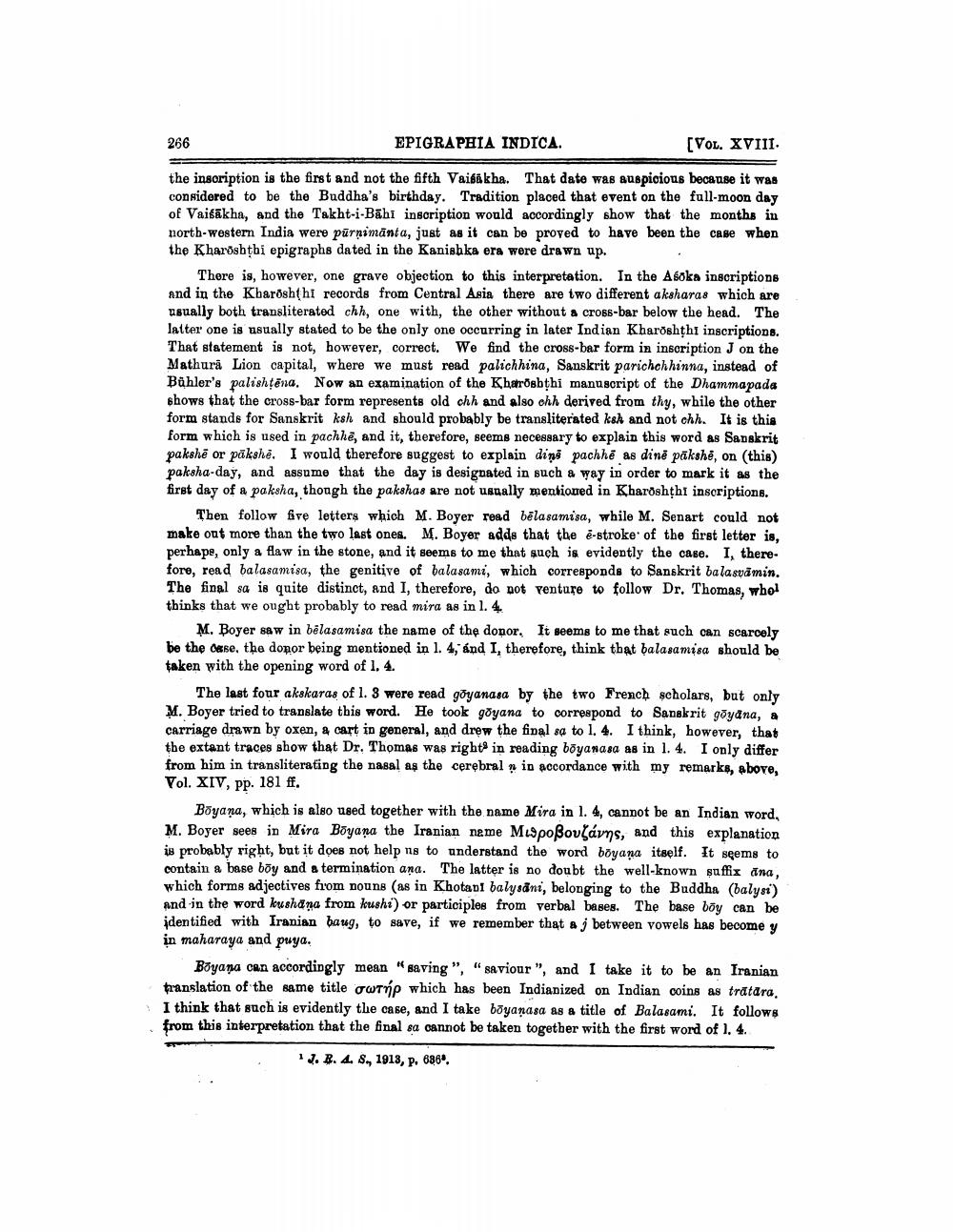________________
266
EPIGRAPHIA INDICA.
[VOL. XVIII.
the insoription is the first and not the fifth Vaisakha. That date was auspicious because it was considered to be the Buddha's birthday. Tradition placed that event on the full-moon day of Vaišākha, and the Takht-i-Bāhi inscription would accordingly show that the months in north-western India were pūrnimānta, just as it can be proved to have been the case when the Kharðshțbi epigraphs dated in the Kanishka era were drawn up.
There is, however, one grave objection to this interpretation. In the Asoka inscriptions and in the Kbarðshthi records from Central Asia there are two different aksharas which are usually both transliterated chh, one with, the other without a cross-bar below the head. The latter one is usually stated to be the only one occurring in later Indian Kharðshthi inscriptions. That statement is not, however, correct. We find the cross-bar form in inscription J on the Mathura Lion capital, where we must read palichhina, Sanskrit parichchhinna, instead of Bühler's palishțēna. Now an examination of the Kharosbțhi manuscript of the Dhammapada shows that the cross-bar form represents old chh and also ohh derived from thy, while the other form stands for Sanskrit ksh and should probably be transliterated ksh and not chh. It is this form which is used in pachhe, and it, therefore, seems necessary to explain this word as Sanskrit pakshē or pākshe. I would therefore suggest to explain dini pachhê as dinē pākshe, on (this) paksha-day, and assume that the day is designated in such a way in order to mark it as the first day of a paksha, though the pakshas are not usually mentioned in Kharoshthi inscriptions.
Then follow five letters which M. Boyer read bēlasamisa, while M. Senart could not make out more than the two last ones. M. Boyer adds that the e-stroke of the first letter is, perhape, only a flaw in the stone, and it seems to me that such is evidently the case. I, therefore, read balasamisa, the genitive of balasami, which corresponds to Sanskrit balasvāmin. The final sa is quite distinct, and I, therefore, do not venture to follow Dr. Thomas, whol thinks that we ought probably to read mira as in l. 4.
M. Boyer saw in bēlasamisa the name of the donor. It seems to me that such can scarcely be the Okse, the donor being mentioned in 1. 4, and I, therefore, think that balasamisa should be taken with the opening word of 1. 4.
The last four akskaras of 1. 3 were read goyanasa by the two French scholars, but only M. Boyer tried to translate this word. He took goyana to correspond to Sanskrit göydna, a carriage drawn by oxen, 4 cart in general, and drew the final sa to 1. 4. I think, however, that the extant traces show that Dr. Thomas was right in reading boyanasa as in 1.4. I only differ from him in transliterating the nasal as the cerebral in accordance with my remarks, above, Vol. XIV, pp. 181 ff.
Boyana, which is also used together with the name Mira in 1. 4, cannot be an Indian word, M. Boyer sees in Mira Böyana the Iranian neme M9 poßovams, and this explanation is probably right, but it does not help ns to understand the word böyana itself. It seems to contain a base boy and a termination ana. The latter is no doubt the well-known suffix ana, which forms adjectives from nouns (as in Khotavi balysäni, belonging to the Buddha (balysi') and in the word kushana from lushi) or participles from verbal bases. The base böy can be identified with Iranian baug, to save, if we remember that aj between vowels has become y in maharaya and puya.
Boyana can accordingly mean "saving", "saviour", and I take it to be an Iranian translation of the same title wtp which has been Indianized on Indian coins as tratara. I think that such is evidently the case, and I take böyanasa as a title of Balasami. It follows from this interpretation that the final sa cannot be taken together with the first word of 1. 4.
13. 8. 4. 8. 1913, P. 686*,




